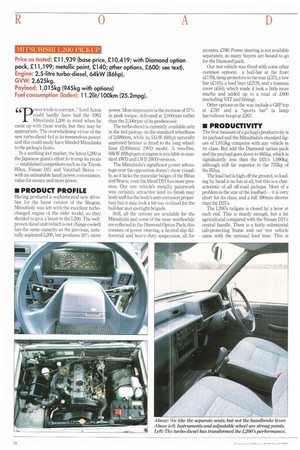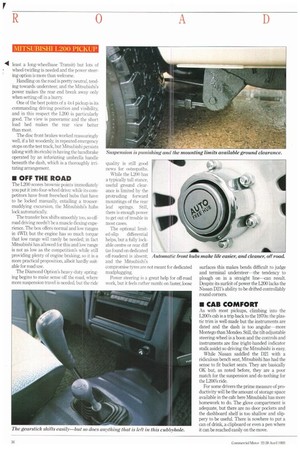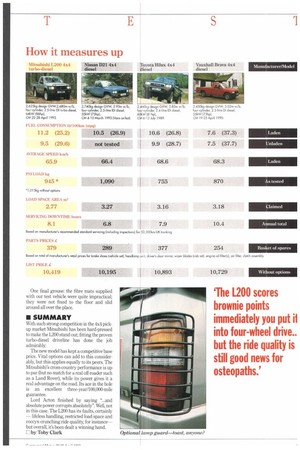Price as tested: £11,939 (base price, E10,419; with Diamond option
Page 36

Page 37

Page 38

Page 39

If you've noticed an error in this article please click here to report it so we can fix it.
pack, £11,199; metallic paint, £140; other options, £600: see text). Engine: 2.5-litre turbo-diesel, 64kW (86hp).
GVW: 2,625kg.
Payload: 1,015kg (945kg with options) Fuel consumption (laden): 11.214/100km (25.2mpg).
4 4 ower tends to corrupt..." Lord Acton
could hardly have had the 1993 Mitsubishi L200 in mind when he came up with these words, but they may be appropriate. The overwhelming virtue of the new turbo-diesel 4x4 is its tremendous power, and this could easily have blinded Mitsubishi to the pickup's faults.
In a seething 4x4 market, the latest L200 is the Japanese giant's effort to trump its rivals — established competitors such as the Toyota Hilux, Nissan D21 and Vauxhall Brava — with an unbeatable hand: power, convenience, value for money and more power.
• PRODUCT PROFILE
Having produced a sophisticated new driveline for the latest version of the Shogun, Mitsubishi was left with the excellent turbocharged engine of the older model, so they decided to give a boost to the L200. The wellproven diesel unit (which is not charge-cooled) has the same capacity as the previous, naturally aspirated L200, but produces 26% more power. More impressive is the increase of 37% in peak torque, delivered at 2,000rpm rather than the 2,500rpm of its predecessor.
The turbo-diesel is currently available only in the 4x4 pickup on the standard wheelbase of 2,680mm, while its 51kW (68hp) naturally aspirated brother is fitted to the long wheelbase (2,950mm) 2W1) model. A two-litre, 69kW (92hp) petrol engine is available in standard 4WD and LWB 2WD versions.
The Mitsubishi's significant power advantage over the opposition doesn't show visually, as it lacks the muscular bulges of the Hilux and Brava; even the bland D21 has more presence. Our test vehicle's metallic paintwork was certainly attractive (and its finish may bode well for the body's anti-corrosion properties) but it may look a bit too civilized for the bull-bar and spotlight brigade.
Still, all the options are available for the Mitsubishi and some of the most worthwhile are collected in the Diamond Option Pack; this consists of power steering, a limited-slip differential and heavy-duty suspension, all for an extra £780. Power steering is not available separately, so many buyers are bound to go for the Diamond pack.
Our test vehicle was fitted with some other common options; a bull-bar at the front (£179), lamp protectors to the rear (£37), a tow bar (£101), a load liner (£219), and a tonneau cover (£64), which made it look a little more macho and added up to a total of £600 (excluding VAT and fitting).
Other options on the way include a GRP top at £787 and a "sports bar" (a lamp bar/rollover hoop) at £267.
• PRODUCTIVITY
The first measure of a pickup's productivity is its payload and the Mitsubishi's standard figure of 1,015kg competes with any vehicle in its class. But add the Diamond option pack and the payload goes down to 945kg, which is significantly less than the D21's 1,090kg, although still far superior to the 755kg of the Hilux.
The load bed is high off the ground, so loading by hand is no fun at ail, but this is a characteristic of all off-road pickups. More of a problem is the size of the loadbed— it is very short for its class, and a full 390nun shorter than the D21's.
The L200's tailgate is closed by a lever at each end. This is sturdy enough, but a bit agricultural compared with the Nissan D21's central handle. There is a fairly substantial cab-protecting frame and our test vehicle came with the optional load liner. This is made of thick, rigid plastic that looks durable, but steals a few more centimetres of load space. The vinyl tonneau cover (another option) fits well and is attached easily to the hooks around the load walls.
Roadworks reduced the L200's average speeds on our Kent test route, but its power advantage let it stomp up the M20 test hill a fair bit faster than the Hilux without having to leave top gear.
Fuel consumption laden, at 1121R/100km (25.2mpg), was the same as the previous, naturally aspirated model but was no match for the direct-injection Brava.
Unladen, the turbo-diesel's torque allowed fifth gear to be used in most conditions and fuel consumption improved significantly to 9.51it/100km (29.6mpg).
• ON THE ROAD
The class-leading power of the new model is immediately apparent: there is a smooth surge of torque from low revs without significant turbo lag or a sudden rush as the turbo comes in, Noise levels are reasonably low, too.
The engine is really very pleasant and predictable and we obtained excellent standingstart acceleration figures in two-wheel-drive, helped, no doubt, by the limited-slip differential. Mind you, it was all too easy to make the tyres squeal when pulling away from a junction. The powerful engine lets the unladen L2( stay in top gear even in the suburbs, but tt gearchange is easy and quick enough for le lazy drivers.
The engine makes fast progress easy, bt there is a limit to the distance a driver wi want to cover because the ride is terribl crashing through potholes and pitching ov( bumps. Things improve slightly when truck is laden, but there seems to be a mi: match between the suspension and the dr ver's seat. This may be due to the option heavy-duty suspension fitted.
Another area where the Mitsubishi coul do better is in its steering the turning circle no worse than that of the Exxon Valdez (or
,11 least a long-wheelbase Transit) but lots of wheel-twirling is needed and the power steering option is more than welcome.
Handling on the road is pretty neutral, tending towards understeer, and the Mitsubishi's power makes the rear end break away only when setting off in a hurry.
One of the best points of a 4x4 pickup is its commanding driving position and visibility, and in this respect the 1.200 is particularly good. The view is panoramic and the short load bed makes the rear view better than most The disc front brakes worked reassuringly well, if a bit woodenly, in repeated emergency stops on the test track, but Mitsubishi persists (along with its rivals) in having the handbrake operated by an infuriating umbrella handle beneath the dash, which is a thoroughly irritating arrangement.
• OFF THE ROAD
The L200 scores brownie points immediately you put it into four-wheel drive: while its competitors have front freewheel hubs that have to be locked manually, entailing a trousermuddying excursion, the Mitsubishi's hubs lock automatically.
The transfer box shifts smoothly too, so offroad driving needn't be a muscle-flexing experience. The box offers normal and low ranges in 4WD, but the engine has so much torque that low range will rarely be needed: in fact Mitsubishi has allowed for this and low range is not as low as the competition's while still providing plenty of engine braking, so it is a more practical proposition, albeit hardly suitable for road use.
The Diamond Option's heavy-duty springing begins to make sense off the road, where more suspension travel is needed, but the ride quality is still good news for osteopaths.
While the L200 has a typically tall stance, useful ground clearance is limited by the protruding forward mountings of the rear leaf springs. Still, there is enough power to get out of trouble in most cases.
The optional limit ed-slip differential helps, but a fully lockable centre or rear diff
(as found on dedicated ANL off-readers) is absent; Automatic front hubs and the Mitsubishi's
compromise tyres are not meant for dedicated mudplugging.
Power steering is a great help for off-road work, but it feels rather numb: on faster, loose surfaces this makes bends difficult to judge and terminal understeer—the tendency to plough on in a straight line—can result. Despite its surfeit of power the L200 lacks the Nissan D21's ability to be drifted controllably round corners.
• CAB COMFORT
As with most pickups, climbing into the I.200's cab is a nip back to the 1970s: the plastic trim is well-made but the instruments are dated and the dash is too angular—more Montego than Monde°. Still, the tilt-adjustable steering-wheel is a boon and the controls and instruments are fine (right-handed indicator stalk aside) so driving the Mitsubishi is easy.
While Nissan saddled the D21 with a ridiculous bench seat, Mitsubishi has had the sense to fit bucket seats. They are basically OK but, as noted before, they are a poor match for the suspension and do nothing for the L200's ride.
For some drivers the prime measure of productivity will be the amount of storage space available in the cab: here Mitsubishi has more homework to do. The glove compartment is adequate, but there are no door pockets and the dashboard shelf is too shallow and slippery to be useful. There is nowhere to put a can of drink, a clipboard or even a pen where it can be reached easily on the move. One final grouse: the fibre mats supplied with our test vehicle were quite impractical; they were not fixed to the floor and slid around all over the place.
• SUMMARY
With such strong competition in the 4x4 pickup market Mitsubishi has been hard-pressed to make the L200 stand out; fitting the proven turbo-diesel driveline has done the job admirably.
The new model has kept a competitive base price. Vital options can add to this considerably, but this applies equally to its peers. The Mitsubishi's cross-country performance is up to par (but no match for a real off-roader such as a Land Rover), while its power gives it a real advantage on the road. Its ace in the hole is an excellent three-year/100,000-mile guarantee.
Lord Acton finished by saying "...and absolute power corrupts absolutely". Well, not in this case. The L200 has its faults, certainly lifeless handling, restricted load space and coccyx-crunching ride quality, for instancebut overall, it's been dealt a winning hand.
E by Toby Clark
















































































